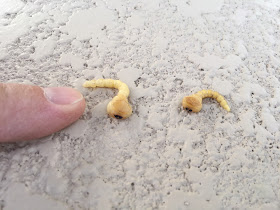Q.
I have a Mexican bird of paradise that was planted five years ago that suddenly
died. It had flourished until now. I pulled out the plant and sent you some
pictures of the dead plant, girdling or circling roots and borers that I found
in the center of the stem that probably killed it.
A.
I read your question and looked at the pictures with quite a bit of interest.
This is the first time I have heard of flatheaded borers infesting Mexican bird
of paradise. These are the same borers that attack fruit trees and landscape
plants.
Flatheaded borers, when they are
young, feed just under the "bark" of the tree in the living vascular
tissue. The center of woody plants is not living so they stay feeding where
they can find water and nutrients. Essentially, they tunnel just under the bark
and parallel with it in a random pattern.
 |
| Flatheaded borers pulled out of the stem of Red Bird of Paradise |
It is here that these larvae find
the most nourishment for growth. When they get larger and ready to pupate or
turn into the winged adult beetle, they burrow towards the center of the plant
where there is not much nourishment. But this area does offer them protection.
Here they begin their metamorphosis
until they finally emerge as the adult beetle which flies away, mates and the
female lays its eggs on the outer surface of susceptible plants.
It’s not unusual to see some
tunneling toward the woody center of limbs or stems. Or at least inside the
wood of some plants.
Girdling roots, larger roots that
grow in circles, occur in plants when they are very young at the nursery. The
roots of these plants are crammed into small nursery containers where they
start growing in circles. They are then moved to larger containers where they
continue to grow in circles.
They are then planted in the
landscape where they continue to grow in circles. Gently remove plants from
their containers and check for girdling roots before purchasing them. This is
the only way you would know if they are girdling or not.
 |
| Girdling roots of Red Bird of Paradise probably started when it was first planted from a seedling. |






















